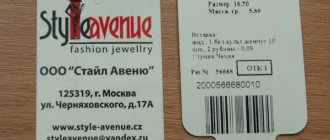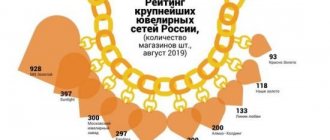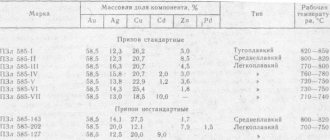The introduction of unified federal accounting systems, providing for mandatory registration of all products entering circulation, is becoming a common practice, which, however, is not without technical difficulties that inevitably arise within each individual industry. The trend has not bypassed the sphere of processing and trading of precious metals - in accordance with the decision taken by the Ministry of Finance and the Federal Assay Office, mandatory marking of jewelry using the GIIS DMDK has been introduced in Russia since 2022. The program is now operating in test mode - initially the deadline for organizations to join the project was set at the end of June, but due to the significant number of participants (over 5 thousand manufacturers and 15 thousand trading enterprises) and the need to fine-tune the registration processes, the deadline was postponed to March 1, 2022 d. Thus, the business has enough time to purchase the required equipment and register personal accounts that allow it to fulfill the new conditions.
What is mandatory labeling of jewelry?
The introduction of unified accounting using QR codes, which are planned to be applied to gold, palladium and platinum products using a laser, is designed to protect buyers from falsification and fraud. The regulator strives to suppress the shadow market and unscrupulous entrepreneurship - both in the field of sales of synthetic counterfeits and smuggling, and in terms of inflating the cost of sold jewelry.
Experts emphasize that it is currently impossible to imitate physical markings, the application of which is within the competence of the Federal Assay Office, which means that the end consumer is guaranteed to receive a high-quality product that meets the declared parameters.
Hallmarks on gold
In all countries, the metal content in alloys is controlled by government agencies, and if jewelry is produced by a jewelry corporation, then verification is carried out internally. For example, in Holland the production of silver and gold products of any quality is completely permitted.
In the Russian Federation, the share of gold in the alloy is determined by the state and is indicated in the decree “On the procedure for testing and marking products made of precious metals.” Products made from such metals must have a state mark and comply with Russian standards.
The testing and hallmarking procedure is carried out by the Russian State Assay Office, located under the Ministry of Finance. And compliance with gold hallmarks and their compliance with reality is monitored by specialists from the Federal Assay Supervision.
In Turkey, Egypt, Greece and the USA, gold and silver products are not controlled. In this regard, Russian jewelers say that 90% of Turkish gold does not correspond to the declared quality: often, with the specified 585th standard, it actually barely reached 500th. But recently, trust in Turkish hallmarks has completely disappeared, the fact is that in any store in this country you can choose an unmarked gold product, after which the seller will put the desired digital marking on it using a special machine.
Usually, the image of the mark combines a certain design and digital marking of the sample, and the sample itself, as mentioned earlier, is placed by government services.
Why do you need an accounting system?
The 2022 Government Decree defining the terms, rules and procedures for marking jewelry and precious metals goods in Russia is a logical result, reflecting the government's desire to increase control over the most significant trading industries. Similar measures have already been implemented in many areas of business, including the sale of medicines, alcoholic beverages, shoes and furs, etc. The use of identification codes allows full access to information about each stage of the transition cycle from manufacturer to retailer, which not only increases the security of transactions, but also simplifies the work of regulatory authorities.
Fines for lack of marking
Russian legislation provides for liability for violation of the rules for the sale of goods subject to mandatory labeling.
- Administrative (Article 15.12 of the Administrative Code):
- for an individual entrepreneur - a fine from 5,000 to 10,000 rubles;
- for a legal entity - a fine from 50,000 to 300,000 rubles.
- Criminal (Part 1 of Article 171.1 of the Criminal Code):
— If the cost of products without markings is more than 1.5 million rubles, the culprit faces imprisonment for up to 3 years and a fine of 80,000 rubles.
Sources:
- https://www.cleverence.ru/articles/auto-busines/markirovka-yuvelirnykh-izdeliy-v-rossii-v-2021-godu-osobennosti-trebovaniya-i-pravila/
- https://astral-cio.ru/articles/markirovka-yuvelirnykh-izdeliy-v-2021-godu/
- https://uvelir.info/articles/markirovka-yuvelirnyih-izdelij-v-rossii-v-2021-godu-osobennosti-trebovaniya-i-pravila-markirovaniya-produktsii-iz-dragotsennyih-metallov—zakon-i-postanovleniya- pravitelstva/
- https://astral.ru/business/markirovka/markirovka-yuvelirnykh-izdeliy/
Ready-made solutions for all areas
Stores
Mobility, accuracy and speed of counting goods on the sales floor and in the warehouse will allow you not to lose days of sales during inventory and when receiving goods.
To learn more
Warehouses
Speed up your warehouse employees' work with mobile automation. Eliminate errors in receiving, shipping, inventory and movement of goods forever.
To learn more
Marking
Mandatory labeling of goods is an opportunity for each organization to 100% exclude the acceptance of counterfeit goods into its warehouse and track the supply chain from the manufacturer.
To learn more
E-commerce
Speed, accuracy of acceptance and shipment of goods in the warehouse is the cornerstone in the E-commerce business. Start using modern, more efficient mobile tools.
To learn more
Institutions
Increase the accuracy of accounting for the organization’s property, the level of control over the safety and movement of each item. Mobile accounting will reduce the likelihood of theft and natural losses.
To learn more
Production
Increase the efficiency of your manufacturing enterprise by introducing mobile automation for inventory accounting.
To learn more
RFID
The first ready-made solution in Russia for tracking goods using RFID tags at each stage of the supply chain.
To learn more
EGAIS
Eliminate errors in comparing and reading excise duty stamps for alcoholic beverages using mobile accounting tools.
To learn more
Certification for partners
Obtaining certified Cleverence partner status will allow your company to reach a new level of problem solving at your clients’ enterprises.
To learn more
Inventory
Use modern mobile tools to carry out product inventory. Increase the speed and accuracy of your business process.
To learn more
Mobile automation
Use modern mobile tools to account for goods and fixed assets in your enterprise. Completely abandon accounting “on paper”.
Learn more Show all automation solutions
Procedure
Industry entities required to register include executive federal bodies, the Central Bank of the Russian Federation, organizations and individual entrepreneurs involved in transactions with precious metals and stones, as well as credit institutions. The operator of the information system is the agency vested with the appropriate powers. The list of requirements for participants includes:
- Obtaining an electronic signature for a manager.
- Drawing up a certificate issued by the Federal Tax Service inspection confirming the absence of debts.
- Preparation of technical equipment and software that allows you to automate accounting, production and trading processes - you can familiarize yourself with the current solutions offered here.
- Conclusion of an agreement with Goznak.
It is worth noting that the introduction of a jewelry labeling system using a product code does not eliminate the need to indicate a sample confirming the percentage of metal in the composition.
Which equipment to choose
Retail outlets that sell jewelry made from precious metals must have a barcode scanner and a cash register connected to the Internet for online operation. Each performed operation is automatically recorded in the unified accounting program simultaneously with the check issuance - the data is received through the fiscal operator.
When choosing a cash register, the priority criteria are sales volumes and the intensity of customer traffic. For small stores with a calm flow, a simple cash register or smart terminal is sufficient, while large companies are recommended to purchase and install complex POS systems that allow you to connect auxiliary peripheral devices. The purchase of a terminal also involves registration with the Federal Tax Service and execution of an agreement with the OFD.
How to Prepare for Change
Taking into account the latest news, the law on the labeling of jewelry, goods and decorations, which defines the rules from 2022, currently leaves room for business to maneuver. The postponement will allow enterprises to efficiently organize the transition to the new system without technical difficulties and in compliance with all legislative norms.
To register in the accounting program, you must submit an application by filling out an online form on the operator’s website and signing it using an electronic signature. The review period is no more than three working days - if a positive decision is made, the operator enters the applicant into the GIIS DMDK register, providing access to his personal account and sending a corresponding notification.
What exactly will need to be marked?
The jewelry tagging program involves applying codes to gold, platinum and palladium, as well as various products made from them, including minted coins. In the case of precious stones, it is planned to use codes on tags for marking.
Today, the need to include silver goods in the list remains in question - current legislative norms provide for testing by manufacturers on a voluntary basis. In addition, identification of composite jewelry weighing less than three grams will not be required.
Popular gold samples
In our country there are five levels of quality of gold products.
375th sample is an alloy containing 38 percent metal (impurities - silver and copper), having a color range from yellow to reddish; over time, this mixture fades.
500th - an alloy with 50.5 percent gold (impurities - silver and copper).
585th is a mixture of 58.5 percent gold with silver, copper, palladium and nickel. This combination makes the product hard, durable, and resistant to air, which is why it is often used in production.
750 is an alloy with a 75.5 percent precious metal content mixed with silver, platinum, copper, nickel and palladium. It can range in color from green and yellow to pink and reddish. Quite durable, but well processed and polished. Very popular for making jewelry, used for high-precision work.
958 is an alloy with a gold content of 95.38 percent, which is rarely used due to its softness and inexpressive color.
Alloys higher than 750 standard are not susceptible to tarnishing when interacting with air, and 999 standard is not used due to poor reliability indicators. For works of art, the 958th standard is best suited, the 900th is used for minting, and for jewelry purposes the 585th standard is used.
How Jewelry Tracking Will Work
The accounting algorithm within the standard cycle of manufacturing, processing, delivery and sale of jewelry products determines the performance of a number of actions by each of the market participants.
Mining company
Organizations engaged in production, as well as customers of complex processing services:
- form raw materials batches;
- send a request for codes and mark each package;
- labeled raw materials are shipped.
Depending on the project, shipment can be carried out to the address of a refinery, a processor within the framework of a tolling scheme, or to the final manufacturer - in this case there is a change of ownership.
Product manufacturing
Receiving a supply of raw materials, the manufacturing company creates semi-finished products suitable for further production of jewelry and sends them for testing, which is carried out by the Federal Assay Office. After returning the material, the production process is carried out. The final products are re-sent to the FPP - if there are no complaints, it is necessary to order marking codes and apply them to each of the labels.
It is important to take into account that as part of the registration of semi-finished products in the accounting system, an obligatory condition is the indication of information about the batch of raw materials used for their production. When determining a sample, a check is also carried out for the compliance of the declared and actual data, the results of which are recorded in the monitoring register and confirmed by accompanying documentation.
Jewelry processor and manufacturer
Receives cargo from the owner that has undergone the marking procedure, after which it processes it, creating a volume of products that meets the stated requirements. Finished products are subject to testing at the FPP, upon completion of which a separate code is ordered for each of them, indicated both on the tag and on the packaging for further transportation.
Refinery
The refining procedure is designed to clean the precious metal from existing impurities, which ultimately increases its value. This service does not provide for the transfer of ownership. Entities involved in the processing cycle perform coordinated operations with batches of unrefined raw materials, after which all or part of the shipment is made back to the owner. A mandatory condition is confirmation of the last fact of receipt of refined precious metal with the provision of relevant information to the GIIS DMDK.
Wholesalers and buyers
They register the change of ownership after receiving jewelry from the manufacturer or individual, and divide the received products for subsequent distribution.
Retail store
Accepts goods from counterparties, which can be wholesale and manufacturing organizations, as well as purchasing offices. Fixes in the accounting system a change in the entity that actually owns the products. When completing a sales transaction, scans the marking code printed on the tag. As a result, information is sent from the online cash register to the OFD, which, in turn, notifies GIIS DMDK about the completion of the cycle and the withdrawal of the product from general trade circulation.
Sale in pawn shops
In this case, we are talking about the sale of goods that were not purchased by the owners or were previously subject to a seizure procedure. As in other cases, a commercial organization is required to apply for labeling data. In this case, sales can be carried out both wholesale, in accordance with the rules established for wholesalers, and at retail - with the simultaneous exclusion of sold jewelry from circulation.
Is the EAC mark necessary on jewelry?
The “EAC” mark is applied to goods that fall under the technical regulations of the EAEU.
Costume jewelry for adults is not subject to mandatory conformity assessment requirements.
Children's jewelry is subject to assessment according to TR CU 017/2011. If costume jewelry is used as a toy for children, then it falls under TR CU 008/2011.
For these children's products, registration of a State Registration Certificate, declaration or certificate is required.
Accordingly, if goods are subject to assessment according to the CU TR, then before they are released for sale, a single mark of circulation on the market “EAS” must be applied to the label. It is applied only after obtaining permits.
Monitoring system
Labeling of gold (as well as other) jewelry in Russia by 2022 should ensure the functioning of a system in which each market participant records the transactions he performs in the accounting register. All consignments of goods are provided with accompanying inventories indicating identifiers, and entities involved in trade turnover have the opportunity to carry out a reconciliation report, in which scanning barcodes makes it possible to confirm the compliance of the declared data.
Tasks of GIIS DMDK
Since the development of the draft program, the range of goals pursued has not actually changed, but has become more specific:
- Introduction of special accounting of all counterparties active in the precious metals industry.
- Creating conditions for documentary tracking of the product distribution cycle - everything starts with raw material shipments and ends with the sale of finished products.
- Simplifying the exchange of information between system participants and supervisory authorities.
- Providing opportunities for comprehensive processing and analysis of data, allowing the generation of statistical and reference reports.
To organize interaction between industry subjects and GIIS DMDK, a personal profile is used, available on the operator’s official website. It is worth emphasizing that when registering for special registration, as well as when deregistering from it, information about the enterprise is checked in detail by the tax service, the Ministry of Internal Affairs and Rosfinmonitoring.
Implementation timeframe
As already mentioned, the government responded to industry feedback and decided to make concessions for business. As a result, in 2022 in Russia, markings on jewelry made of gold and other precious metals and stones will be implemented in a trial format, allowing each organization to voluntarily prepare and join the GIIS DMDK. The mandatory registration date is March 1, 2022.
A year after this, physical laser identification of jewelry with QR codes that will be applied in the stamp area will become an essential condition, and the countdown of the 12-month period allotted for the sale of unmarked goods will begin. Well, in the spring of 2024, the system will begin to function in full - without exceptions or easing.
Residue marking
The procedure for including products actually at the disposal of retail outlets, wholesalers and other market participants into circulation is as follows:
The enterprise notifies the supervisory authorities about its available reserves, characterizing them in quantitative terms, and receives an appropriate set of digital identifiers - in the event that it has no debts to the Federal Tax Service, there are no unpaid fines and penalties, and an agreement has been concluded with Goznak.
The company produces and attaches an additional label to the product - indicating the code in graphical and numerical form, as well as a link to the official resource where you can check the information. The technical parameters of the equipment and software used must ensure the ability to print materials that meet the established standard, so if you are looking for a comprehensive solution, we recommend paying attention to proven options from Cleverence.
The accounting system records the characteristics of the object, including information about weight, fineness, presence of inserts, as well as a photograph of the decoration. The specific requirements for the design of tags when labeling jewelry are determined by the regulator’s desire to create conditions under which the buyer can at any time clarify the compliance of the product with the declared data, the legality of its origin, etc.
It is also important for producers and producers to take into account that the FPP must provide information not only on finished products, but also on inserts and precious metals, divided in accordance with supply contracts confirming their origin. Each batch receives its own code, indicated when releasing goods.
Labeling deadlines
Mandatory labeling in the jewelry industry was supposed to start at the beginning of 2022, but market participants were not ready for the new requirements, and the deadline had to be postponed.
The new deadlines are determined by Decree of the Government of the Russian Federation of February 26, 2022 No. 270.
| March 1, 2022 | From this day on, products (materials and decorations) produced or imported into the Russian Federation must have labels with Data Matrix codes, and participants in trade turnover must register the following information in the DMDK:
Barcodes for precious metals bars can be applied to passports and certificates. |
| March 1, 2023 | Each product item must have a marking code. Without a nanotag, you cannot produce or import “jewelry” from abroad, but for now you can store the remainder in a warehouse. |
| March 1, 2024 | Physical nanotags must be applied to all residues by this date. From March 1, 2024, stores will not be able to sell jewelry without a marking code. |
Where and how to apply barcodes
When placing identifiers, it is planned to implement two feasible solutions.
Option number one involves applying the Data Matrix and EAN-13 codes associated in the commodity accounting program to the tag. At the same time, only the first of them is important for GIIS DMDK, so if there is insufficient free space, it is recommended to leave it or use a shortcut book.
The second option is nanoengraving on the metal surface, carried out by FPP using special laser equipment.
The dimensions of the identifier, which also serves as a QR code, do not exceed 1 square millimeter, so the marking of jewelry will not affect its value and appearance. This proposal was first introduced within the framework of the Moscow Financial Forum 2022, and is one of the stages of the project. Number of impressions: 5839
What to do with the leftovers?
So, from March 1, 2022, all jewelry produced or brought from abroad must enter the market with an additional attached label (price tag or tag), which contains:
- UIN (forms GIIS DMDK using special software);
- barcode generated based on the UIN (Data Matrix);
- Internet site address for obtaining information about a specific piece of jewelry.
Also, each piece of jewelry must have a digital photograph - provided by the manufacturer to the DMDK system along with other information about the product (to obtain a UIN).
For jewelry leftovers released before the start of mandatory labeling, special rules apply.
Until January 15, 2022, wholesalers, stores and other market participants must enter into the GIIS information on the balances of precious metals, stones and finished products as of January 1, 2022. Before April 1, 2022, it is necessary to re-take the inventory and provide current information taking into account goods sold from January 1 to March 31.
From September 1, 2022, all “jewelry” declared as surplus must have labels with a UIN and a barcode. In this form, the products can be legally sold until March 1, 2023. From this date, sales are possible only with physical tags. Industry participants will have exactly one year to put an engraving on all balances; from March 1, 2024, products without a nanomark can neither be sold nor simply kept on balance sheet.
We will select marking equipment for any budget!










